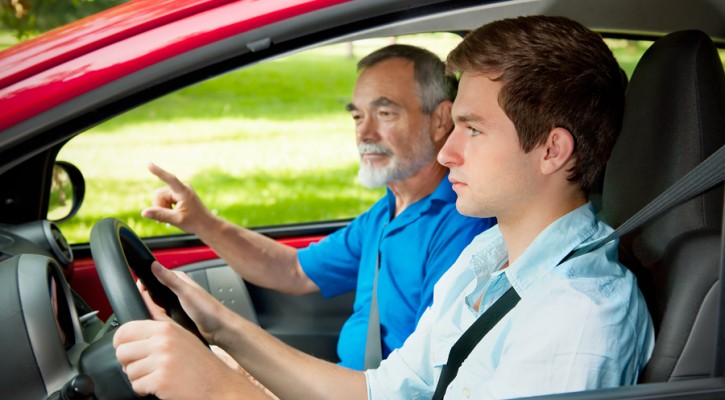Tag Archive: teen driver safety

How to Use a Teen Driving Checklist
April 14, 2009
Teaching their teen to drive is a stressful experience for many parents. The parent is nervous about the teen driver’s safety, while the teen is giddy with excitement. Parents may be ambivalent about this rite of passage because it means their child is growing up, while teens are eager for the new level of freedom and independence associated with a driver’s license. The parent wants the teen to absorb as much information about the driver training process as possible; the teen just wants to learn enough to pass the road test.
One way to manage driver training sessions is to use a Teen Driving Checklist. The checklist provides an opportunity to review concepts and provide feedback on the driving lesson. Using this tool provides structure to each lesson, which facilitates learning for the teen and helps the parent feel more comfortable about the process of teaching the teen to drive.
The parent should complete one copy of the checklist during each lesson. Before the parents share it with the teen at the end of the lesson, the teen can complete a second copy of the evaluation. This self-evaluation helps teens learn to assess the driving behavior of themselves and other drivers, a critical concept once they are out on the road on their own. After the teen finishes the self-assessment, the two checklists should be compared and discussed in detail.
Parents should be sure to acknowledge areas of improvement as well as make a note of skills that need further discussion and practice. If the driving lesson was particularly difficult, parents can wait a few hours to have the discussion, but it should take place prior to the next driving lesson so the teen won’t continue to practice bad habits.
Since the checklist includes basic, intermediate, and advanced skills, parents can easily tailor each driving lesson to a specific set of skills. Avoid packing too much into one driving lesson, which could overwhelm the teen driver. It is better to hold a few extra lessons than to take a chance on skimping on a teen driver’s knowledge of critical driving skills.

Alcohol Access and Your Teen: Is Your Teen Mature Enough to Drink?
March 12, 2009
So your teen is having some friends over to “hang out.” Your teen wants you to provide a movie, snacks, and a six-pack of beer. Should you do it? Isn’t it safer to have your teen home with you so you can provide supervision? When you were young, the drinking age was 18, and you turned out fine. Isn’t it more important to teach your teen to be a responsible drinker than to abide by a law that features an arbitrary age limit?
Some parents do provide teens with alcohol, or simply look the other way when their teens drink, espousing a “kids will be kids” attitude. They think there is nothing they can do to stop the teen from drinking. They fear their teen’s reaction to a strict prohibition against drinking. They want to be their teen’s friend because they want to keep the lines of communication open.
Some parents think that if the teen only drinks alcohol in their own home, the parents will be in control of the amount consumed. They think they can keep watch over their teen to make sure that nothing bad happens while the teen is intoxicated. They reason that at least this way, their teen isn’t driving drunk or riding with another drunk teen. They rationalize that if they let the teen’s friends sleep over, everyone will be safe.
But these parents aren’t taking many facts into account that refute the notion that parents should allow underage children to drink:
- Teenagers are not physically, mentally or emotionally ready to be under the influence. Even one alcoholic drink is too much for their developing bodies and brains.
- For every year under the age of 21 a teenager begins drinking alcohol, they are five times more likely to battle a lifetime of alcohol abuse and dependence (National Institute on Drug Abuse, 2005)
- Adolescent use of alcohol increases the risk of dependence because teens’ brains are not fully developed. The prefrontal cortex, which we use to assess situations, help us use good judgment, and keep our emotions and desires under control, does not develop completely until we are in our early 20s (NIDA, 2007)
- Teenagers may look mature, but their bodies are still developing. They require a lower level of consumption of alcohol to obtain a rapid “high,” which means their judgment is affected almost immediately, but they also have increased levels of alcohol tolerance, making it easy for them to overindulge.
- Teenagers are emotionally immature. They are still learning about themselves, relationships, and what direction they should take in life. Because even a small amount of alcohol reduces inhibitions and impairs judgment, they may react emotionally while under the influence without considering the consequences of their behavior.
- The use of alcohol by teens increases the risk of activities that may result in serious long-term consequences, including:
- Use of other drugs (alcohol is a gateway drug because its use compromises judgment and reduces inhibitions)
- Driving under the influence
- Alcohol poisoning from binge drinking (teens often binge drink to relax and may participate in drinking games that result in ingestion of large quantities of alcohol in a short period of time)
- Increased sexual activity and multiple sexual partners due to lowered inhibitions, which increases the risk of pregnancy and/or sexually transmitted diseases
- Exacerbation of underlying, perhaps undiagnosed, mental illness
- Violence and rape (whether the victim is under the influence or not)
- Suicide
Parental accountability for social hosting is on the rise. Twenty-four states have enacted social hosting laws to hold adults criminally responsible for providing alcohol to minors. No state makes it legal for an adult to provide alcohol to other people’s children. Civil suits can result in the loss of many or all of a person’s assets – whether they knew alcohol was being served in the home or not. Turning a blind eye is not an excuse.
When you host a gathering for your teen, you must tighten your resolve. Avoid being a friend and focus on your role as the parent. The following tips will help you through the process:
- Set expectations with your teen ahead of time. Make sure your teen knows that you will not allow alcohol (or other drugs) at the party and that this is communicated to all guests. Ask your teen to tell you about any concerns she or he has about any of the guests or any situations that could occur. Make your neighbors aware of the party and enlist their help in monitoring the area.
- Make a guest list with your teen. Limit the number of teens so you can be sure of adequate chaperonage. Be sure you have contact information on each teen’s parent. Make sure guests and their parents understand that if a teen leaves the party, she or he won’t be allowed to return and parents will be called. Make sure parents who won’t be chaperoning know the start and end times of the party and will prearrange transportation.
- Limit guest access to certain areas of the house and property. Lock up all valuables, breakables, alcohol and weapons. Plan activities to occupy the guests. Provide plenty of snacks, soda and water. Set an example by not providing alcohol for any adults who are present. Regularly move through the party unannounced and as inconspicuously as possible, checking any off-limit areas. Collect all keys so you can keep track of who is arriving and leaving. Keep coats and purses in an area that can be monitored. Speak to each person before they leave; check for warning signs of impairment.
- If a guest arrives at the party already under the influence of alcohol or other drugs, keep them there while you call a parent to pick them up. If the guest leaves and someone is hurt or injured, you could be held responsible.

Five Worst Teen Driving Mistakes: Part One
December 11, 2008
Most parents live in dread of the day their teens get driver’s licenses and get behind the wheel on their own. Their concerns are well-founded, since teen drivers have the highest death rates in car crashes of any age group. Motor vehicle crashes are the number one cause of death among Americans aged 15-20. But parents can help their teens be a safer driver even after they are licensed, particularly by paying attention to common risk factors. In this five-part series, we’ll discuss the five worst teen driving mistakes:
- They don’t wear safety belts.
- They drink and drive.
- They panic/overcorrect in emergency situations.
- They drive too fast for conditions.
- They ride with other teens.
In this, part one of the series, we’ll emphasize the importance of wearing safety belts. First, you’ll need to set the right example for your children by wearing your safety belt. “Do as I stay, not as I do,” doesn’t work with teens, particularly when they’re out of your sight and you can’t personally enforce the rule.
Also, make sure you never pull out of your driveway or a parking space until everyone in the vehicle is wearing a seat belt. Many high school students fail to use their safety belts even when riding with adults who are buckled up. An observational survey conducted at 12 high schools found that 46 percent of high school students were not wearing their safety belts when riding with adult drivers. About half of the unbelted students were riding with adults who were belted. If your teens are used to wearing safety belts as passengers, they’ll be comfortable wearing them as drivers.
Next, educate your teen about the benefits of wearing safety belts. Here’s some supportive information:
- Research has found that lap/shoulder safety belts, when used, reduce the risk of fatal injury to front-seat passenger car occupants by 45 percent and the risk of moderate-to-critical injury by 50 percent. For light truck occupants, safety belts reduce the risk of fatal injury by 60 percent and moderate-to-critical injury by 65 percent.
- Ejection from the vehicle is one of the most injurious events that can happen to a person in a crash. In fatal crashes in 2005, 75% of passenger car occupants who were totally ejected from the vehicle were killed. Safety belts are effective in preventing total ejections. Only 1% of the occupants reported to have been using restraints were totally ejected, compared with 30% of the unrestrained occupants.
- Safety belts should always be worn, even when riding in vehicles equipped with air bags. Air bags are designed to work with safety belts, not alone. Air bags, when not used with safety belts, have a fatality-reducing effectiveness rate of only 12 percent.
Third, educate your teen about the safety belt laws in your state. Be sure to review the graduated licensing laws – safety belt enforcement may differ from that of fully licensed drivers.
Statistical source: National Highway Traffic Safety Administration
Keep Teens Driving on the Straight and Narrow
September 6, 2006
Having clear-cut rules about the family car and/or driving privileges in general seems like a smart plan for teenagers. After all, most of our parents just tell us to be careful and then impose restrictions after the fact for some indiscretion. Having to guess what the family rules are sometimes can be compared to a weather report – partly cloudy.
There is this recent news story about parents setting rules before we get into the car. Well, of course, we would love to be free to do what we want, but at least if we knew the rules in advance, we could not grumble about not knowing that we did something wrong! And parents – be consistent with us teenagers ok? We’re confused enough as it is without the parental unit changing their minds.
Some parents really think about our driving and come up with a lot of do’s and don’ts for us while others sort of make it up as they go along. Parents take the advice of this teenager – we will push every limit possible when it comes to our driving privileges so you better really, really think about the rules you want to set!
Here are some of the most common rules that we teenagers are familiar with: obeying speed limits, not having more passengers in the car than allowed, and no drinking. However, there are a few things that we are going to do unless you tell us or catch us doing them. We are likely going to use our cell phones and drive at the same time. The same goes for eating or drinking a soda. We have also been known to change the radio station with one hand or text message a friend behind the wheel of a car. Many times, parents do not think of these things and these are what can get us in trouble.
Now other teenagers are probably yelling at me for telling all our secrets, but come on! Why get in trouble for those same things later when we can avoid doing them now. Besides, no matter how much the parental unit may rain on our parades, they mean well and only want the best for us. Add the fatality record of teenager drivers and the parents can definitely back up their case. Why don’t we give them a break for a change and actually follow the rules – well, these rules anyway.
This post is an excerpt from a recent edition of the Safe Driving Teen Monthly Bulletin. Each month the National Safety Commission publishes the bulletin for teens and parents designed to improve teen driver behavior, attitude, skills, and experience. Subscription Details
